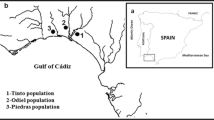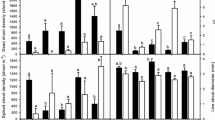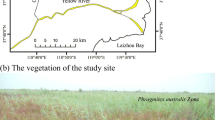Abstract
Spartina alterniflora and Spartina densiflora are native salt marsh plants from the Atlantic coast; their habitats in Patos Lagoon estuary (southern Brazil) are characterized by a microtidal regime (<0.5 m) and, during El Niño events, high estuarine water levels and prolonged flooding due to elevated freshwater discharge from a 200,000-km2 watershed. During and between El Niño events, the vegetative propagation of these two Spartina species in the largest estuary of southern Brazil (Patos Lagoon) was evaluated by monitoring transplanted plants for 10 years (short-term study) and interpreting aerial photos of natural stands for 56 years (long-term study). During the short-term study, S. alterniflora quickly occupied mud flats (up to 208 cm year−1) by elongation of rhizomes, whereas S. densiflora showed a modest lateral spread (up to 13 cm year−1) and generated dense circular-shaped stands. However, moderate and strong El Niño events can promote excessive flooding and positive anomalies in the estuarine water level that reduce the lateral spread and competitive ability of S. densiflora. During the long-term study, natural stands of S. alterniflora and S. densiflora had steady lateral spread rates of 152 and 5.2 cm year−1, respectively, over mud flats. In the microtidal marshes of the southwest Atlantic, the continuous long-term lateral expansion of both Spartina species embodies periods of intense flooding stress (moderate and strong El Niños), when there is a decrease of vegetative propagation and less stressful low water periods of fast spread over mud flats (non-El Niño periods and weak intensity El Niños).





Similar content being viewed by others
References
Adam, P. 1990. Saltmarsh ecology. New York: Cambridge University Press.
Alberti, J., M. Escapa, P. Daleo, O. Iribarne, B. Silliman, and M. Bertness. 2007. Local and geographic variation in grazing intensity by herbivorous crabs in SW Atlantic salt marshes. Marine Ecology Progress Series 349: 235–243.
Alberti, J., A.M. Casariego, P. Daleo, E. Fanjul, B. Silliman, M. Bertness, and O. Iribarne. 2010. Abiotic stress mediates top-down and bottom-up control in a Southwestern Atlantic salt marsh. Oecologia 163: 181–191.
Alves, E.S., S.A. Rodrigues, and P.R. Pezzuto. 2005. Estudo do crescimento relativo de Austinixa patagoniensis (Rathbun) (Decapoda, Pinnotheridae) simbionte de Callichirus major (Say) (Decapoda, Callianassidae) no mesolitoral da praia de Balneário Camboriú, Santa Catarina, Brasil. Revista Brasileira de Zoologia 22: 784–792.
ANA. 2010. http://hidroweb.ana.gov.br. Accessed 08 Sept 2010.
Arenovski, A.L., and B.L. Howes. 1992. Lacunal allocation and gas transport capacity in the salt marsh grass Spartina alterniflora. Oecologia 90: 316–322.
Ayres, M., M. Ayres, D.L. Ayres, and A.S. Santos. 2007. BioEstat 5.0 Aplicações Estatísticas nas áreas das Ciências Biológicas e Médicas. Belém: Sociedade Civil Mamirauá, MCT, Imprensa Oficial do Estado do Pará.
Berkenbusch, K., and A.A. Rowden. 2000. Latitudinal variation in the reproductive biology of the burrowing ghost shrimp Callianassa filholi (Decapoda: Thalassinidea). Marine Biology 136: 497–504.
Bertness, M.D. 1991. Zonation of Spartina patens and Spartina alterniflora in a New England salt marsh. Ecology 72: 138–148.
Bertness, M.D., and A.M. Ellison. 1987. Determinants of pattern in a New England salt marsh plant community. Ecological Monographs 57: 129–147.
Bertness, M.D., and S.W. Shumway. 1992. Consumer driven pollen limitation of seed production in marsh grasses. American Journal of Botany 79: 288–293.
Bortolus, A. 2006. The austral cordgrass Spartina densiflora Brong.: Its taxonomy, biogeography and natural history. Journal of Biogeography 33: 158–168.
Bortolus, A., and O. Iribarne. 1999. Effects of the SW Atlantic burrowing crab Chasmagnathus granulata on a Spartina salt marsh. Marine Ecology Progress Series 178: 79–88.
Callaway, J.C., and M.N. Josselyn. 1992. The introduction and spread of smooth cordgrass (Spartina alterniflora) in South San Francisco Bay. Estuaries 15: 218–226.
Câmara, G., R.C.M. Souza, U.M. Freitas, and J. Garrido. 1996. SPRING: Integrating remote sensing and GIS by object-oriented data modelling. Computers and Graphics 20: 395–403.
Castillo, J.M., L. Fernández-Baco, E.M. Castellanos, C.J. Luque, M.E. Figueroa, and A.J. Davy. 2000. Lower limits of Spartina densiflora and S. maritima in a Mediterranean salt marsh determined by different ecophysiological tolerances. Journal of Ecology 88: 801–812.
Costa, C.S.B. 1997. Tidal marsh and wetland plants. In Subtropical convergence environments: The coast and sea in the Southwestern Atlantic, ed. U. Seeliger, C. Odebrecht, and J.P. Castello, 24–26. Berlin: Springer.
Costa, C.S.B., and A.J. Davy. 1992. Coastal saltmarsh communities of Latin America. In Coastal plant communities of Latin America, ed. U. Seeliger, 179–199. California: Academic Press, Inc.
Costa, C.S.B., U. Seeliger, and P.G. Kinas. 1988. The effect of wind velocity and direction on the salinity regime in the Lower Patos Lagoon estuary. Ciência e Cultura 40: 909–912.
Costa, C.S.B., J.C. Marangoni, and A.M.G. Azevedo. 2003. Plant zonation in irregularly flooded salt marshes: Relative importance of stress tolerance and biological interactions. Journal of Ecology 91: 951–965.
Costa, C.S.B., F.L. Coimbra, and D. Gianuca. 2005. Impacto do Pulso de Limnificação 2000–2004 sobre a paisagem das marismas do sul do Brasil: Estudo de caso da Ilha da Pólvora (Rio Grande, RS). Anais do VII Congresso de Ecologia do Brasil. Caxambu, MG. 1113a. CD-ROM. http://www.seb-ecologia.org.br/viiceb/resumos/1113a.pdf. Acessed 06 Jan 2009.
Costa, C.S.B., U. Seeliger, and C.E. Bemvenuti. 2010. Diagnóstico de Alterações Hidrológicas Devido ao Impacto das Mudanças Climáticas Sobre o Ecossistema Costeiro Temperado Brasileiro (Rio Grande do Sul) Através da Vegetação e do Macrozoobentos. Brasília: Ministério do Meio Ambiente/PROBIO.
Coultas, C., G.A. Breitenbeck, W.L. Kruczynski, and C.B. Subrahmanyam. 1978. Vegetative stabilization of dredge spoil in North Florida. Journal of Soil and Water Conservation 33: 183–185.
D’Incao, F., K.G. Silva, M.L. Ruffino, and A.C. Braga. 1990. Hábito alimentar do caranguejo Chasmagnathus granulata Dana, 1851 na Barra do Rio Grande, RS (Decapoda, Grapsidae). Atlantica 12: 85–93.
Daehler, C., and D.R. Strong. 1996. Status, prediction and prevention of introduced cordgrass Spartina spp. invasions in Pacific estuaries, USA. Biological Conservation 78: 51–58.
Daleo, P., J. Alberti, A. Canepuccia, M. Escapa, E. Fanjul, B.R. Silliman, M.D. Bertness, and O. Iribarne. 2008. Mycorrhizal fungi determine salt-marsh plant zonation depending on nutrient supply. Journal of Ecology 96: 431–437.
Dworschak, P.C. 1998. Observations on the biology of the burrowing mud shrimps Callianassa tyrrhena and C. candida (Decapoda: Thalassinidea). Journal of Natural History 32: 1535–1548.
Eleuterius, L.N. 1970. Observations on Claviceps purpurea on Spartina alterniflora in the coastal marshes of Mississippi. Gulf Research Reports 3: 105–109.
Fang, X., P.K. Subudhi, B.C. Venuto, S.A. Harrison, and A.B. Ryan. 2004. Influence of flowering phenology on seed production in smooth cordgrass (Spartina alterniflora Loisel). Aquatic Botany 80: 139–151.
Feist, B.E., and C.A. Simenstad. 2000. Expansion rates and recruitment frequency of exotic smooth cordgrass, Spartina alterniflora (Loisel), colonizing unvegetated littoral flats in Willapa Bay, Washington. Estuaries 23: 267–274.
Figueroa, M.E., and E.M. Castellanos. 1988. Vertical structure of Spartina maritima and Spartina densiflora in Mediterranean marshes. In Plant form and vegetation structure, ed. M.J.A. Werger, P.J.M. Van Der Aart, H.J. During, and J.T.A. Verboeven, 105–108. The Hague: SPB Academic Publishing.
Garcia, C.A.E. 1997. Hydrographic characteristics. In Subtropical convergence environments: The coast and sea in the Southwestern Atlantic, ed. U. Seeliger, C. Odebrecht, and J.P. Castello, 18–20. Berlin: Springer.
Garcia, A.M., M.B. Raseira, J.P. Vieira, K.O. Winemiller, and A.M. Grimm. 2003. Spatiotemporal variation in shallow-water freshwater fish distribution and abundance in a large subtropical coastal lagoon. Environmental Biology of Fishes 68: 215–228.
Godfrey, P.J., and M.M. Godfrey. 1974. The role of overwash and inlet dynamics in the formation of salt marshes on North Carolina Barrier Islands. In Ecology of halophytes, ed. R.J. Reimold and W.H. Queen, 407–427. New York: Academic Press, Inc.
Granato, G.E. 2006. Kendall-Theil Robust Line (KTRLine—version 1.0)—A visual basic program for calculating and graphing robust nonparametric estimates of linear-regression coefficients between two continuous variables: Techniques and Methods of the U.S. Geological Survey. Book 4 (A7). http://pubs.usgs.gov/tm/2006/tm4a7/pdf/TM4-A7_KTRLine_report.pdf. Accessed 31 Aug 2010.
Grevstad, F.S. 2005. Simulating control strategies for a spatially structured weed invasion: Spartina alterniflora (Loisel) in Pacific Coast estuaries. Biological Invasions 7: 665–677.
Grimm, A.M., S.E.T. Ferraz, and J. Gomes. 1998. Precipitation anomalies in Southern Brazil associated with El Niño and La Niña events. Journal of Climate 11: 2863–2880.
Harrington, L.M.B., and J.A. Harrington. 1992. Spartina invasion in the Palix estuary. In Paper and Proceedings of Applied Geography Conferences, eds. J.W. Frazier, B.J. Epstein, and F.A. Schoolmaster, 56–60.
Hartmann, J.M. 1988. Recolonization of small disturbance patches in a New England salt marsh. American Journal of Botany 75: 1625–1631.
INPE. 2007. El Niño e La Niña http://www.cptec.inpe.br/enos/. Accessed 16 Jan 2007.
Iribarne, O., A. Bortolus, and F. Botto. 1997. Between-habitat differences in burrow characteristics and trophic modes in the southeastern Atlantic burrowing crab Chasmagnathus granulata. Marine Ecology Progress Series 155: 137–145.
Kittelson, P.M., and M.J. Boyd. 1997. Mechanisms of expansion for an introduced species of cordgrass, Spartina densiflora, in Humboldt Bay, California. Estuaries 20: 770–778.
Kruczynski, W.L. 1982. Salt marshes of the northeastern Gulf of Mexico. In Creation and restoration of coastal plant communities, ed. R.R. Lewis, 71–88. Boca Raton: CRC Press.
Marengo, J.A., and M.C. Valverde. 2007. Caracterização do clima no Século XX e Cenário de Mudanças de clima para o Brasil no Século XXI usando os modelos do IPCC-AR4. Revista Multiciência 8: 05–28.
Masunari, S., N. Dissenha, and R.C. Falcão. 2005. Crescimento relativo e destreza dos quelipodos de Uca maracoani (Latreille) (Crustacea, Decapoda, Ocypodidae) no Baixio Mirim, Baía de Guaratuba, Paraná, Brasil. Revista Brasileira de Zoologia 22: 974–983.
Mateos-Naranjo, E., S. Redondo-Gómez, C.J. Luque, E.M. Castellanos, A.J. Davy, and M.E. Figueroa. 2008. Environmental limitations on recruitment from seed in invasive Spartina densiflora on a southern European salt marsh. Estuarine, Coastal and Shelf Science 79: 727–732.
Mendonça, P.T., and C.S.B. Costa. 2008. Efeitos da disponibilidade de nitrogênio e fósforo no estabelecimento de Spartina alterniflora em um plano entremarés irregularmente alagado. Neotropical Biology and Conservation 3: 135–148.
Metcalfe, W.S., A.M. Ellison, and M.C. Bertness. 1986. Survivorship and spatial development of Spartina alterniflora Loisel. (Graminae) seedlings in a New England salt marsh. Annals of Botany 58: 249–258.
Miller, W.G. 2008. OpenStat: A free statistics package for instruction and analyses. http://www.statpages.org/miller/openstat. Accessed 06 Jan 2008.
Mobberley, D.G. 1956. Taxonomy and distribution of the genus Spartina. Iowa State College Journal of Science 30: 471–574.
Möller, O.O., J.P. Castello, and A.C. Vaz. 2009. The effect of river discharge and winds on the interannual variability of the pink shrimp Farfantepenaeus paulensis production in Patos Lagoon. Estuaries and Coasts 32: 787–796.
Nieva, F.J.J., A. Díaz-Espejo, E.M. Castellanos, and M.E. Figueroa. 2001. Field variability of invading populations of Spartina densiflora Brong. in different habitats of the Odiel Marshes (SW Spain). Estuarine, Coastal and Shelf Science 52: 515–527.
Nieva, F.J.J., E.M. Castellanos, J.M. Castillo, and M.E. Figueroa. 2005. Clonal growth and tiller demography of the invader cordgrass Spartina densiflora Brongn. at two contrasting habitats in SW European salt marshes. Wetlands 25: 122–129.
NOAA—Tides & Currents. 2010. http://tidesandcurrents.noaa.gov/geo.shtml?location=9418767. Accessed 08 Sept 2010.
Pezzuto, P.R. 1993. REGRANS: A “Basic” program an extensive analysis of relative growth. Atlantica 15: 93–105.
Proffitt, C.E., and J. Young. 1999. Salt marsh plant colonization, growth, and dominance on large mudflats created using dredged sediments. In Symposium-Recent research in Coastal Louisiana: Natural system function and response to human influence, eds. L.P. Rozas, J.A. Nyman, C.E. Proffitt, N.N. Rabalais, D.J. Reed, and R.E. Turner, 218–228. Louisiana Sea Grant College Program.
Proffitt, C.E., S.E. Travis, and K.R. Edwards. 2003. Genotype and elevation influence Spartina alterniflora colonization and growth in a created salt marsh. Ecological Applications 13: 180–192.
Ratchford, S.G. 1995. Changes in the density and size of newly settled clams in Willapa Bay, Washington, due to the invasion of smooth cordgrass, Spartina alterniflora Loisel. (M.S. Thesis, University of Washington).
Redfield, A.C. 1972. Development of a New England salt marsh. Ecological Monographs 42: 201–237.
Riggs, S. 1992. Distribution of Spartina alterniflora in Padilla Bay, Washington, in 1991. Washington State Department of Ecology, Padilla Bay National Estuarine Research Reserve (Technical Report N°3, Mount Vernon, Washington).
Rosso, P.H., S.L. Ustin, and A. Hastings. 2006. Use of lidar to study changes associated with Spartina invasion in San Francisco Bay marshes. Remote Sensing of Environment 100: 295–306.
Santos, M., and S.L. Almeida. 2000. Anatomia foliar de Spartina Schreber (Poaceae) da Ilha de Santa Catarina (Florianópolis, SC). Ínsula 29: 1–24.
Sayce, K. 1988. Introduced cordgrass, Spartina alterniflora Loisel, in salt marshes and tidelands of Willapa Bay, Washington. Willapa National Wildlife Refuge. USFWS Contract #FWSI–87058 (TS).
Vaz, A.C., O.O. Moller, and T.L. Almeida. 2006. Análise quantitativa da descarga dos rios afluentes da Lagoa dos Patos. Atlantica 28: 13–23.
Wang, C.H., L. Tang, S.F. Fei, J.Q. Wang, Y. Gao, Q. Wang, J.K. Chen, and B. Li. 2009. Determinants of seed bank dynamics of two dominant helophytes in a tidal salt marsh. Ecological Engineering 35: 800–809.
Woodhouse, W.W., E.D. Seneca, and S.W. Broome. 1974. Propagation of Spartina alterniflora for substrate stabilization and salt marsh development. Technical Memorandum N° 46. U.S. Army, Corps of Engineers. Coastal Engineering Research Center.
Xiao, D., L. Zhang, and Z. Zhu. 2010. The range expansion patterns of Spartina alterniflora on salt marshes in the Yangtze Estuary, China. Estuarine, Coastal and Shelf Science 88: 99–104.
Yeager, D.P., and G.R. Ultsch. 1989. Physiological regulation and conformation: A BASIC program for the determination of critical points. Physiological Zoology 62: 888–907.
Zar, J.H. 1999. Biostatistical analysis, 4th ed. USA: Prentice-Hall, Inc.
Acknowledgments
This research was supported by the Brazilian Research Council for Science and Technology (CNPq). We are extremely grateful to the anonymous referees for the discussion and voluminous comments.
Author information
Authors and Affiliations
Corresponding author
Rights and permissions
About this article
Cite this article
Marangoni, J.C., Costa, C.S.B. Short- and Long-Term Vegetative Propagation of Two Spartina Species on a Salt Marsh in Southern Brazil. Estuaries and Coasts 35, 763–773 (2012). https://doi.org/10.1007/s12237-011-9474-7
Received:
Revised:
Accepted:
Published:
Issue Date:
DOI: https://doi.org/10.1007/s12237-011-9474-7




